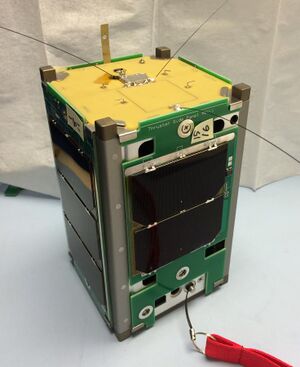Engineering:BRICSat-2
From HandWiki
Revision as of 11:41, 5 July 2022 by imported>TextAI (fix)
Short description: Experimental amateur radio satellite
 | |
| Mission type | Communications |
|---|---|
| Operator | U.S. Navy[1] |
| COSPAR ID | 2019-036S[1] |
| SATCAT no. | 44355[1] |
| Spacecraft properties | |
| Bus | 1.5U Cubesat[2] |
| Manufacturer | George Washington University |
| Launch mass | 1 kg (2.2 lb) |
| Start of mission | |
| Launch date | 25 June 2019, 06:30 UTC |
| Rocket | Falcon Heavy |
| Launch site | Kennedy LC-39A |
| Contractor | SpaceX |
| End of mission | |
| Decay date | 20 April 2022[3] |
| Orbital parameters | |
| Reference system | Geocentric |
| Regime | Low Earth |
| Semi-major axis | 6,925 kilometres (4,303 mi)[4] |
| Perigee altitude | 310.4 kilometres (192.9 mi)[4] |
| Apogee altitude | 799.0 kilometres (496.5 mi)[4] |
| Inclination | 28.5323°[4] |
| Period | 95.6 minutes[4] |
| Mean motion | 15.06277419[4] |
| Epoch | 7 April 2020[4] |
| Transponders | |
| Band | FM |
BRICSat-2 (Ballistically Reinforced Communication Satellite 2), or USNAP1, was an experimental amateur radio satellite from the United States Naval Academy that was developed in collaboration with George Washington University. BRICSat-2 was the successor to BRICSat-P. AMSAT North America's OSCAR number administrator assigned number 103 to this satellite; in the amateur radio community it was therefore called Navy-OSCAR 103, short NO-103.[5]
Mission
BRICSat-2 was launched on June 25, 2019 with a Falcon Heavy from Kennedy Space Center, Florida, United States , as part of Mission STP-2 (Space Test Program 2) as one of 24 satellites.
Frequencies
- 145.825 MHz - Uplink APRS digital repeater, 1200 bd
- 145.825 MHz - Downlink APRS digital repeater
- 437.605 MHz - Telemetry, 9600 bd (callsign USNAP14)
See also
- OSCAR
References
- ↑ 1.0 1.1 1.2 "BRICSAT 2". NSSDCA. NASA Goddard Space Flight Center. https://nssdc.gsfc.nasa.gov/nmc/spacecraft/display.action?id=2019-036S. Retrieved 3 February 2020.
- ↑ Erik Kulu. "BricSat-2 (USNA-P1, BricSat-2, BricSat-D, Ballistically Reinforced Communication Satellite, PSat B, ParkinsonSat B". Nanosats database. https://www.nanosats.eu/sat/bricsat-2. Retrieved 3 February 2020.
- ↑ "BRICSAT 2 (NO-103)". N2YO.com. 20 April 2022. https://www.n2yo.com/satellite/?s=44355.
- ↑ 4.0 4.1 4.2 4.3 4.4 4.5 4.6 "BRICSAT 2 (NO-103)". N2YO.com. https://www.n2yo.com/satellite/?s=44355. Retrieved 7 April 2020.
- ↑ Glasbrener, Drew (5 August 2020). "BRICSAT2 and PSAT2 Designated Navy-OSCAR 103 (NO-103) and Navy-OSCAR 104 (NO-104).". https://www.amsat.org/bo-102. Retrieved 3 February 2020.
External links
 |

